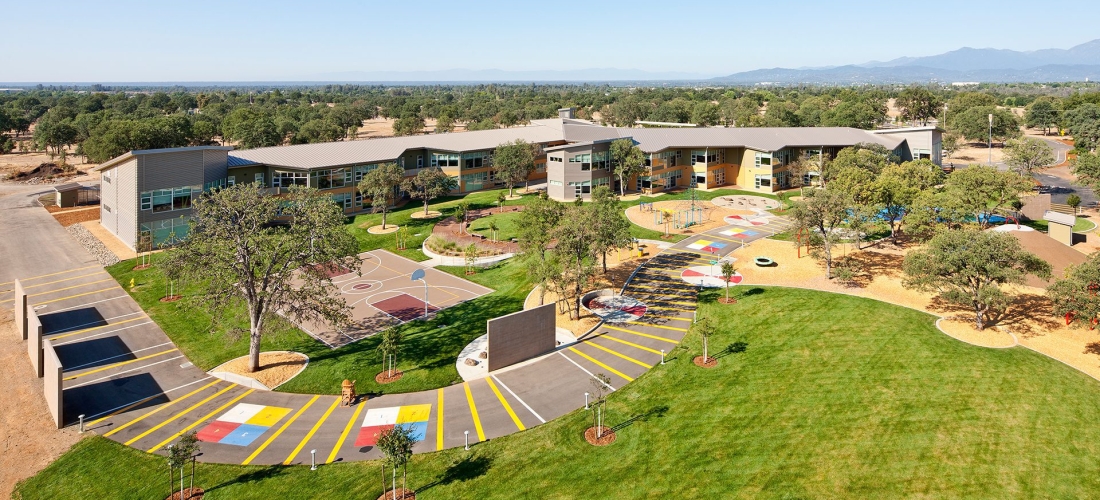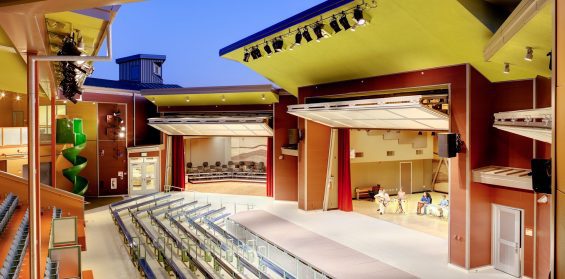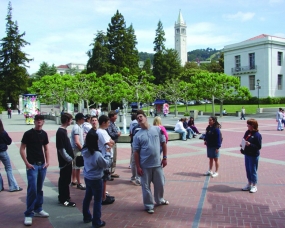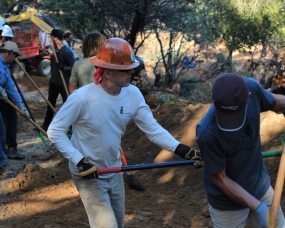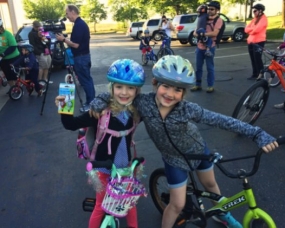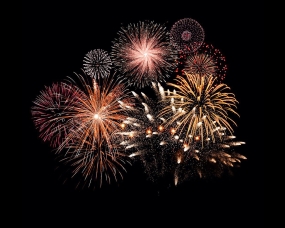RSA – A Cool School with a Purpose – Redding, California
Redding School of the Arts opened its state-of-the-art campus in 2011. The McConnell Foundation funded the $30 million building project as a program-related investment for the community, and the LEED Platinum certified building, owned by the Foundation, continues to evolve and inspire. RSA, a public charter school, leases the facility. The campus is not only a national model of energy efficiency and sustainability, winning state and national awards, it is a large sustainability laboratory and arts exploratorium for the students and community.
The design of the school campus is based on two essential ideas: that creative, colorful, healthy, and fun surroundings can inspire students to learn; and that the built environment creates opportunities to show students, teachers, and the community that sustainability is part of each day. Every aspect of the facility is purpose-built for a visual and performing arts school, with a focus on green architecture and sustainable use.
The original two-story, 77,000 square foot building encompasses large, brightly painted classrooms, art rooms, music and dance rooms, a library and information center, a cooking classroom, science lab and a technology lab. The innovative playground offers areas for gross and fine motor skills, imaginative play, organized team sports, and active free-play. The outdoor learning spaces that surround the school encourage blending indoor and outdoor education, allowing the students to experience the fresh air and peacefulness of nature surrounding them and creating a more reflective environment for the students to be calm and experience the beauty. Even the music classes can be found playing in the outside courtyards with their music drifting down the exterior hallways for all to enjoy.
A signature element of the school campus is the 600-seat open-air amphitheater located in the central core of the main building. Designed as a “hole to the sky,” with three enclosed dance and drama classrooms that can open to create outdoor performance venues, the amphitheater has served as the school’s main performance space since the school opened in 2011. A retractable shade structure was added in 2017 in order to maximize use of this outdoor space during bright, sunny days. In addition to school shows and assemblies and guest artist performances, the amphitheater is a popular venue in the community especially during warm nights when twinkling stars add to the beauty of music or dance. The intimate center theater area, which can seat 115 people, is becoming a favorite for many local and traveling artists as a performance theater, and due to the excellent sound and lighting design, the space rivals any small theater space in town with easy access for audience members of all abilities.
In 2012, the original school campus became the first in the world to be certified Platinum under the stringent LEED for Schools 2009 standards. It was designed with an overall commitment to environmental sensitivity — a sustainable energy design including a 121-kw photovoltaic system, solar water heaters, a wind turbine and a 175,000-gallon underground water storage tank for rainwater collected from the roof and used for the school’s summer irrigation. The school’s design and features continue to win state and national awards.
Recognizing the school’s growing after-school program and increasing activity needs, in 2018, the Foundation added a versatile activity center that opens to a secure garden courtyard. Designed for multiple purposes and open spaces, students may be found inside eating their lunches on cold, wet days, gathered for presentations, tumbling over gymnastic mats or outside under the covered patio visiting with their friends after school, playing games, or digging in the garden. With close proximity to the technology lab and library, many students can get extra help after school with assignments. An average of 300 students use the activity center on any given day.
Designed to rigorous environmental standards, the new activity center is the first building in the North State to achieve LEED v4 certification. The 5,000 square foot building is also expected to be the first commercial facility in Shasta County to achieve true net-zero energy status, producing as much energy as it uses.
The school’s unique garden teaching space, connected to the new activity center, provides many cross-curricular learning opportunities such as predicting and monitoring seed germination in science journals, measuring and graphing plant growth, and producing beautiful flowers and vegetable still life drawings. Moreover, the fruit trees have reached a size where the tree-ripened fruit are a welcomed addition to the students’ snacks, allowing them to experience farm-to-table eating first hand. RSA has presented at state conferences about the school’s environmental education program where students experience the campus’ energy efficient features and transfer the information of the four R’s — recycle, reuse, reduce and rot to their home lives. Students at RSA have opportunities to make daily choices to reduce their environmental footprint to help our planet’s future.
RSA strives to give back to the community by providing its beautiful campus for use by many community organizations, from the YMCA, to children’s dance and drama studios, to STEAM camps, to cultural institutions. Some organizations use the three outdoor stages or classrooms, while others use the Activity Center or outside spaces. When using the energy efficient facility, these community organizations personally experience green energy at work while learning and growing in whatever their activities might be.
RSA alumni and the community are proud of their school facility, attending performances, painting murals in the playground to add to the friendly and inclusive play area for all students, and supporting the school’s arts and environmental programs. Having a school that is truly an environmentally responsible, vibrant, living, learning environment, filled with whimsical, child-centered features, engages students wherever they may be on campus and serves as a catalyst for formal and informal lessons on sustainability.
